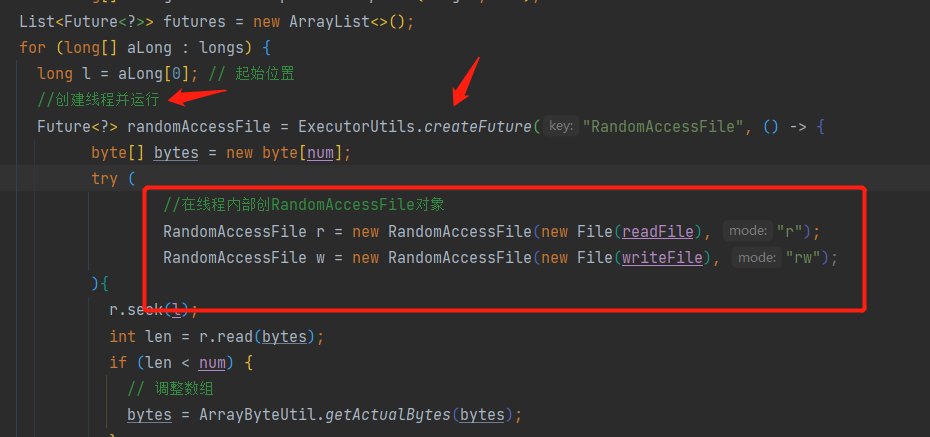Java-Io-RandomAccessFile
胡安民 人气:0介绍
RandomAccessFile是java语言中最丰富的文件访问类。RandomAccessFile类支持随机访问方式,可以跳转到文件的任意位置读写数据,这个类在文件随机读取时有很大的优势,可利用多线程完成对一个大文件的读写,利用seek对文件进行切分,从大文件的不同位置开线程进行读写。
构造,模式,方法
RandomAccessFile他的构造函数只有两种,所以仅限于操作文件,不能访问其他io设备,比如网络,内存映像等。

而底层是使用c/c++进行操作的,所以无法进行自定义操作

如果RandomAccessFile作为输出流时,写出到的文件如果不存在,则在执行过程中自动创建 如果写出到的文件存在,则会对原有文件内容进行覆盖。(默认情况下,从头覆盖)
| 模 式 | 作 用 |
|---|---|
| r | 表示以只读方式打开,调用结果对象的任何write方法都将导致抛出IOException |
| rw | 打开以便读取和写入,如果该文件尚不存在,则尝试创建该文件 |
| rws | 打开以便读取和写入,相对于"rw",还要求对文件内容或元数据的每个更新都同步写入到底层存储设备 |
| rwd | 打开以便读取和写入,相对于"rw",还要求对文件内容的每个更新都同步写入到底层存储设备 |
| 方 法 | 作 用 |
|---|---|
void close() | 重要,关闭此随机访问文件流并释放与该流关联的所有系统资源 |
| FileChannel getChannel() | 返回与此文件关联的唯一FileChannel对象,NIO用到 |
long getFilePointer() | 返回此文件中的当前偏移量(实时) |
long length() | 返回此文件的长度 |
| int read() | 从此文件中读取一个数据字节 |
int read(byte[] b) | 将最多b.length个数据字节从此文件读入byte数组,返回读入的总字节数,如果由于已经达到文件末尾而不再有数据,则返回-1。 |
| int read(byte[] b, int off, int len) | 将最多len个数据字节从此文件的指定初始偏移量off读入byte数组 |
| boolean readBoolean() | 从此文件读取一个boolean,其余readByte()、readChar()、readDouble()等类似 |
String readLine() | 从此文件读取文本的下一行 (会乱码) |
void seek(long pos) | 重要,设置到此文件开头测量到的文件指针偏移量,在该位置发生下一个读取或写入操作(字节单位) |
| int skipBytes(int n) | 重要,尝试跳过输入的n个字节以丢弃跳过的字节,返回跳过的字节数 |
void write(byte[] b) | 将b.length个字节从指定byte数组写入到此文件中 |
| void write(byte[] b, int off, int len) | 将len个字节从指定byte数组写入到此文件,并从偏移量off处开始 |
| void write(int b) | 向此文件写入指定的字节 |
| void writeBoolean(boolean v) | 按单字节值将boolean写入该文件,其余writeByte(int v)、writeBytes(String s)、writeChar(int v)等都类似 |
问题解决
文件覆盖改追加
在RandomAccessFile作为输入流时候,第一次写的时候会将文件从头覆盖,后面在写就是追加(同一个对象) ,如果想在第一次就追加的话那么就设置写的位置w.seek(w.length());这样就会从文件的最后一个字节之后开始写了
try (
RandomAccessFile r = new RandomAccessFile(new File(readFile), "r");
RandomAccessFile w = new RandomAccessFile(new File(writeFile), "rw");
){
w.seek(w.length()); // 将指针指向文件最后,进行追加
byte[] bytes = new byte[1024];
int len = -1;
while ((len = r.read(bytes)) != -1) {
w.write(bytes);
}
} catch (IOException e) {
e.printStackTrace();
}案例文件读写
CodeStartAndStopTimeUtil.creator(
() -> {
File file = ResourceFileUtil.getFile("mp4/mp4_2.zip");
String readFile = file.getAbsolutePath();
String writeFile = file.getParent() + File.separator + "mp4_11112.zip";
byte[] bytes = new byte[2048];
try (RandomAccessFile r = new RandomAccessFile(new File(readFile), "r");
RandomAccessFile w = new RandomAccessFile(new File(writeFile), "rw"); ) {
int len = -1;
while ((len = r.read(bytes)) != -1) {
w.write(bytes);
}
}
});
}案例多线程文件读写
CodeStartAndStopTimeUtil.creator(
() -> {
File file = ResourceFileUtil.getFile("mp4/mp4.zip");
String readFile = file.getAbsolutePath();
String writeFile = file.getParent() + File.separator + "mp4_11112.zip";
long length = new File(readFile).length(); // 文件一共大小
int num = (int)length/8; // 每个线程读写多少字节 20971520(20mb) 2.5个g4~5秒左右
List<long[]> longs = DataGroup.dataGroupOnce(length, num);
List<Future<?>> futures = new ArrayList<>();
for (long[] aLong : longs) {
long l = aLong[0]; // 起始位置
// 创建线程并运行
Future<?> randomAccessFile =
ExecutorUtils.createFuture(
"RandomAccessFile",
() -> {
byte[] bytes = new byte[num];
try (
// 在线程内部创RandomAccessFile对象
RandomAccessFile r = new RandomAccessFile(new File(readFile), "r");
RandomAccessFile w = new RandomAccessFile(new File(writeFile), "rw"); ) {
r.seek(l);
int len = r.read(bytes);
if (len < num) {
// 调整数组
bytes = ArrayByteUtil.getActualBytes(bytes);
}
// 写入文件
w.seek(l);
w.write(bytes);
System.out.println(l );
} catch (IOException e) {
e.printStackTrace();
}
});
futures.add(randomAccessFile);
}
// 阻塞全部线程执行完毕
ExecutorUtils.waitComplete(futures);
});问题
多线程使用RandomAccessFile
常见的使用多线程的场景: 断点续传和断点下载,或者文件加密解密等
断点续传原理就是:
- 前端将文件安装百分比进行计算,每次上传文件的百分之一(文件分片),给文件分片做上序号
- 后端将前端每次上传的文件,放入到缓存目录
- 等待前端将全部的文件内容都上传完毕后,发送一个合并请求
- 后端使用RandomAccessFile进多线程读取所有的分片文件,一个线程一个分片
- 后端每个线程按照序号将分片的文件写入到目标文件中,
- 在上传文件的过程中发生断网了或者手动暂停了,下次上传的时候发送续传请求,让后端删除最后一个分片
- 前端重新发送上次的文件分片
解决readLine乱码的问题
RandomAccessFile 读写文件时,不管文件中保存的数据编码格式是什么 使用 RandomAccessFile对象方法的 readLine() 都会将编码格式转换成 ISO-8859-1 所以 输出显示是还要在进行一次转码
//需要重新转码才能正常显示 System.out.println( new String(r.readLine().getBytes(StandardCharsets.ISO_8859_1), StandardCharsets.UTF_8) );
多线程读写乱码的问题
RandomAccessFile对象是不能线程共享的,一个RandomAccessFile对象的文件指针只有一个,多个线程如果都去操作这个指针进行seek的话,那么读写就会被来回的跳转,导致多个线程的读写混乱,所以每个线程必须在线程内部创建RandomAccessFile,这样每个线程都有一个自己的文件指针了, 正确案例

加载全部内容